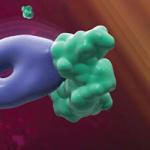
Research Topics
Dr. Pike’s Section is focused on developing novel radioactive probes (radiotracers) for the investigation of neuropsychiatric disorders with PET. This research mainly encompasses medicinal chemistry for probe discovery and radiochemistry for labeling candidate probes with a short–lived positron-emitter, invariably cyclotron-produced carbon-11 (t1/2 = 20 min) or fluorine-18 (t1/2 = 110 min).
PET is a uniquely powerful means for investigating the biochemical workings of the brain in living human subjects, including those suffering from neuropsychiatric disorders. The power of PET in clinical research derives from the use of radiotracers that are specific for a particular important biochemical process (e.g., glucose metabolism) or a low-density protein target (e.g., a neurotransmitter receptor), where the process or target is suspected of playing a major role in one or more brain disorders (e.g. the serotonin transporter in depression). Currently, radiotracers do not exist for the myriad of possible targets. The discovery and development of suitable radiotracers is in fact a major challenge in realizing the full research potential of PET (much like drug discovery).
In Dr. Pike’s laboratory, radiotracers for imaging and quantifying various protein targets (e.g., plaques, transporters, or neurotransmitter receptors) in brain are in development. These targets include Aβ-amyloid plaque, TSPO (previously known as PBR) binding sites, the efflux transporter P-gp and the receptors mGluR5, CB1 and 5-HT1A. Candidate probes are evaluated in animal and normal human subjects in close cooperation with the Imaging Section of the Molecular Imaging Branch, led by Dr. Innis. Successful probes are then introduced into clinical studies with PET for investigating various disorders, such as neuroinflammatory conditions (stroke, Alzheimer’s disease, and traumatic brain injury), addiction (alcoholism), autism, anxiety and depression.
Development of methodology for radiolabeling with carbon-11 and fluorine-18 is key to successful radiotracer development, and is a major component of the Section's research. Currently, this includes the exploration of i) methods to accelerate labeling reactions (e.g., the use of microfluidics or microwaves), ii) chemistry to allow fluorine-18 to be introduced into previously inaccessible molecular positions, iii) semi-robotic approaches to safe and reliable radiotracer production, and iv) the use of mass spectrometry to independently verify radiotracer specific activity, investigate metabolic pathways and provide arterial input functions for PET imaging.
A full list of publications and more information on the research activities of Dr. Pike’s laboratory are available at the laboratory Web Site.
Biography
Dr. Pike received his B.Sc. (Hons) degree in chemistry from the University of Birmingham (UK) in 1972 and his Ph.D. in organic chemistry from the same University in 1975. Following a postdoctoral fellowship at Birmingham University, he joined the MRC Cyclotron Unit (Imperial College, London) in 1978 at the foundation of its strong research program in positron emission tomography (PET), eventually becoming Head of its Chemistry and Engineering Section with a strong personal interest in all chemical aspects of the discovery, development and evaluation of novel radioactive probes for molecular imaging with PET. Dr. Pike was awarded the Marie Curie Award and Springer Prize for his work in this area. He joined the Molecular Imaging Branch of NIMH in 2001 as Chief of the PET Radiopharmaceutical Sciences Section (PRSS).
Selected Publications
- Lu S, Haskali MB, Ruley KM, Dreyfus NJ, DuBois SL, Paul S, Liow JS, Morse CL, Kowalski A, Gladding RL, Gilmore J, Mogg AJ, Morin SM, Lindsay-Scott PJ, Ruble JC, Kant NA, Shcherbinin S, Barth VN, Johnson MP, Cuadrado M, Jambrina E, Mannes AJ, Nuthall HN, Zoghbi SS, Jesudason CD, Innis RB, Pike VW. PET ligands [18F]LSN3316612 and [11C]LSN3316612 quantify O-linked-β-N-acetyl-glucosamine hydrolase in the brain. Sci Transl Med. 2020;12(543).
- Jakobsson JE, Lu S, Telu S, Pike VW. [11 C]Carbonyl Difluoride-a New and Highly Efficient [11 C]Carbonyl Group Transfer Agent. Angew Chem Int Ed Engl. 2020;59(18):7256-7260.
- Hong J, Telu S, Zhang Y, Miller WH, Shetty HU, Morse CL, Pike VW. Translation of 11C-labeled tracer synthesis to a CGMP environment as exemplified by [11C]ER176 for PET imaging of human TSPO. Nat Protoc. 2021.
- Ikawa M, Lohith TG, Shrestha S, Telu S, Zoghbi SS, Castellano S, Taliani S, Da Settimo F, Fujita M, Pike VW, Innis RB, Biomarkers Consortium Radioligand Project Team.. 11C-ER176, a Radioligand for 18-kDa Translocator Protein, Has Adequate Sensitivity to Robustly Image All Three Affinity Genotypes in Human Brain. J Nucl Med. 2017;58(2):320-325.
- Haskali MB, Pike VW. [11 C]Fluoroform, a Breakthrough for Versatile Labeling of PET Radiotracer Trifluoromethyl Groups in High Molar Activity. Chemistry. 2017;23(34):8156-8160.
Related Scientific Focus Areas
This page was last updated on Thursday, January 18, 2024

